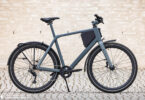The original Smart was small, agile, …smart. And at first, a two-seater. As such, the all-new Smart #1 breaks with tradition in terms of both looks and size. The same applies to pricing. Read on to find out whether the all-electric compact SUV from the German-Chinese joint venture remains smart, nonetheless.
The #1 model name sounds like something of a debut. Indeed, the new compact E-SUV from Smart can be considered a new beginning for the brand. As little as it’s got to do with its eponymous predecessors, the #1 ushers in a new era of EVs bearing the Smart logo. It’s the first vehicle to come from the brand since Smart were resuscitated by the 50:50 joint venture between the Mercedes-Benz Group and Geely, founded in 2019. While the design and development still take place in Germany, the #1 is ultimately a Chinese production. We had the opportunity to test drive and experience the Premium Edition Smart #1 extensively, priced at almost € 45,000.


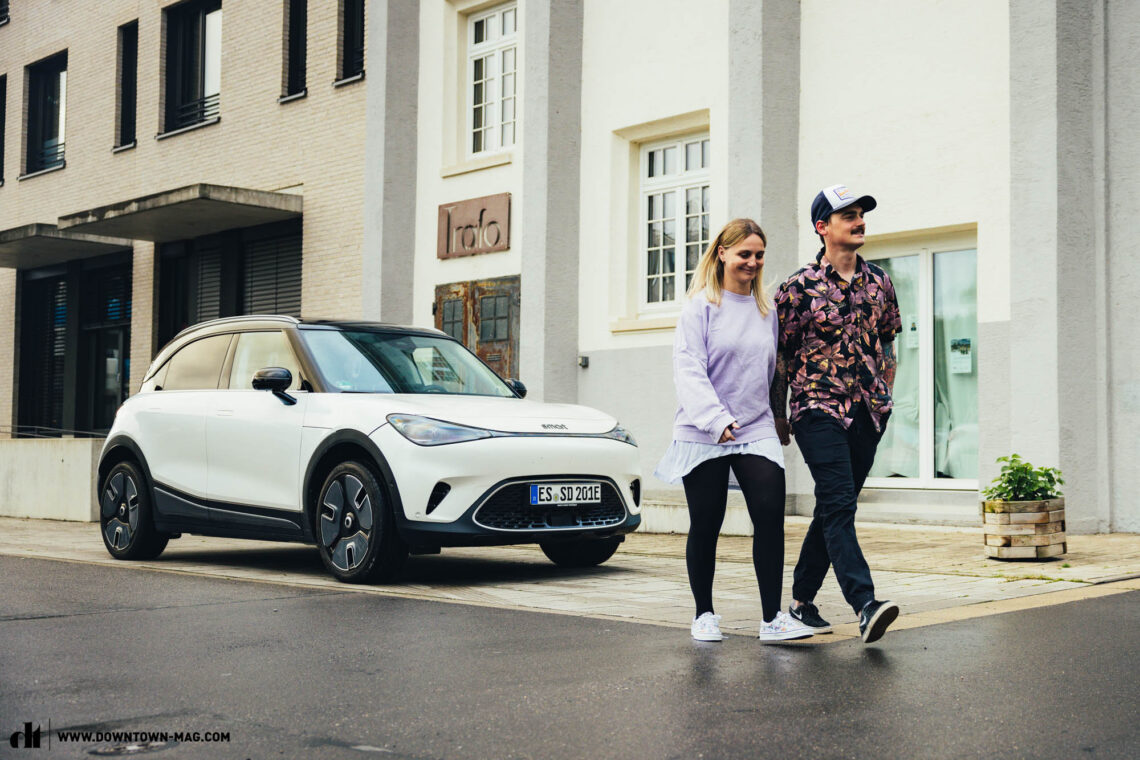
From Pro+ to BRABUS – There’s no such thing as basic with the Smart #1!
Good concepts often turn out to be too good for the real world. True innovations like the VW Lupo 3L or the Audi A2 have disappeared from the market faster than they took to develop – and they remain highly sought after by connoisseurs on the used car market. But the profit margin of these innovative, fuel-efficient vehicles often doesn’t make them worthwhile for corporations to produce. The Smart – effectively the blueprint for modern compact cars – has also garnered a large fan base. However, it never made Mercedes a lot of money. And now, with the launch of the #1, it’s got a new lease on life with a new partner from the Far East. However, the first electric car of the newly founded joint venture is no longer a small car. At least not according to the Central European idea of a small car.

But it’s here where small cars offering smart solutions would help alleviate inner city congestion the most, using less parking space and making mobility more sustainable. Unfortunately, the exact opposite is happening, and SUVs are trendier than ever before. Most cars are getting bigger, heavier, and more powerful with every iteration. The same goes for the Smart #1:
It is neither small nor affordable. However, Smart aren’t the only ones: at VW, vehicles below the ID.3 are treated just as abjectly as small EVs at Audi, BMW and co. It’s not a welcome trend and we only hope that other manufacturers – likely from the Far East – will jump in to fill the gap.


Perhaps we as Central Europeans also need to re-evaluate our concept of a small car. After all, the world has stopped revolving around us a long time ago, and markets like China have become much more important. There – and even more so in the USA – the Smart #1 is still a small car, looking cute amid monster SUVs and pickups. Size is a matter of perspective, after all.
Just the names of the model variants alone provide an indication of the Smart #1’s trajectory: away from everyday pragmatism, towards luxury and performance. From Pro+ to BRABUS – everything is more premium, just like the name of our test car. And they all have an output of at least 200 kW. If you want even more, you can have it: the BRABUS version with dual motors and all-wheel drive generates a whopping 315 kW – and the price is an equally whopping € 48,990. For the petrol heads amongst us, that’s equivalent to 428 hp. But where is the fairly priced, entry-level model with sensible everyday features? The pricing for the new Smart #1 starts at € 42,490, which isn’t exactly cheap.

Design and dimensions – A roomy feeling Smart
When first encountering the still extremely rare Smart #1, you would be forgiven for thinking you’ve seen it before. While the “floating” halo roof sets the electric SUV apart to some degree, it ultimately lacks the unmistakable, idiosyncratic look of the original Smart. The rounded design looks a little dull, and the face of the #1 is somewhat reminiscent of a frog from certain angles. However, with its optionally colour-contrasted roof and continuous light strips on the front and rear, the new electric Smart looks snazzy, nonetheless.


The latest iteration of the Smart has clearly outgrown its microcar shoes. At 4.27 m, the #1 surpasses its predecessor, the EQ Forfour, by almost 80 cm in length, thus finally arriving in the compact class, comparable to a VW ID.3, which it even beats by 7 cm in height. That said, the compact E-SUV looks anything but clunky, which is also reflected in the handling. In fact, the handling reminds us more of the 40 cm shorter Honda e. But more on that later…

We could find hardly any fault in the workmanship and finishing quality. While the new Smart is no longer made in Germany, the Chinese manufacturers Geely obviously know what they’re doing. The exterior is impeccably finished, boasting uniform tolerances and flawless paintwork. The flush door handles with their engraved Smart logo are a nice touch, looking sleek and streamlined. Despite the SUV genes, the #1 looks quite aerodynamic, not least because of the rotor design of its 19-inch wheels. The rear end looks a bit chubby in comparison, but that makes the car likeable somehow. And this impression is carried over seamlessly into the interior. With a name like Dark Matter, the interior colour way calls up images of a black hole, but the inside of the compact SUV feels very friendly. The dark seats are contrasted with light accents, and the bright roof liner together with the large panoramic glass roof provide a sense of spaciousness. The immediately visible surfaces, many of which are covered with synthetic leather, also feel high-quality to the touch. Less visible surfaces like those in the trunk, however, are made of a simpler plastic material.
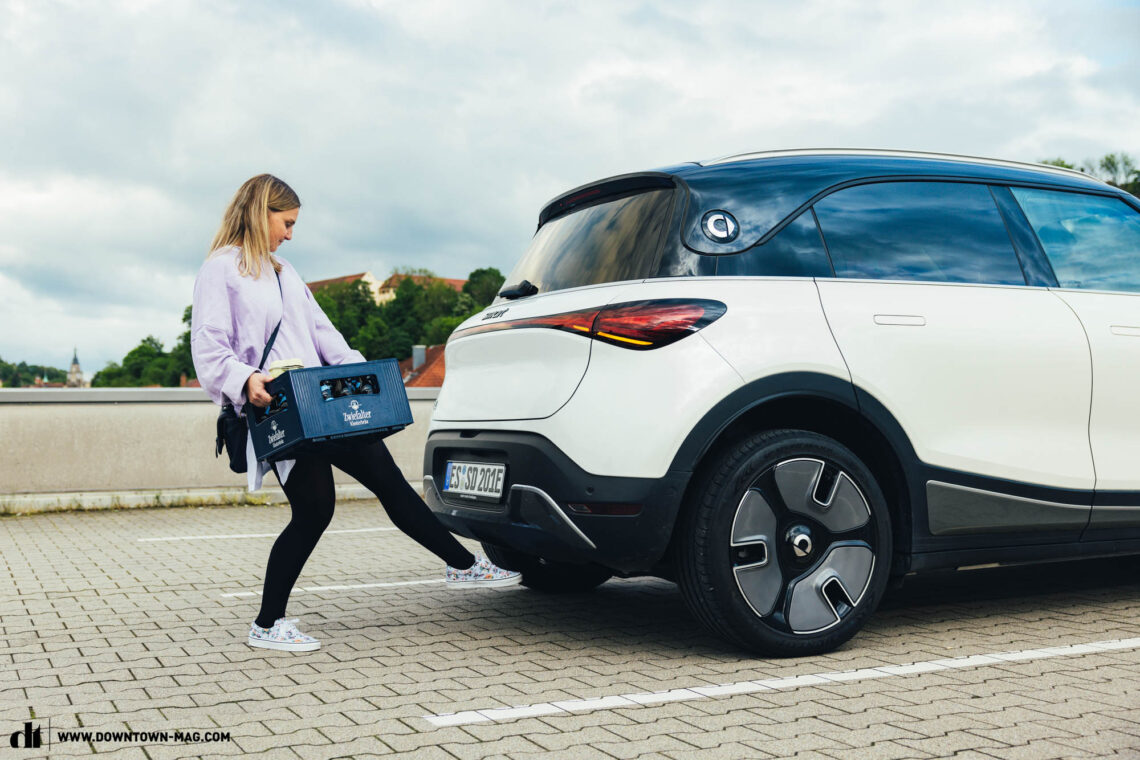
Speaking of the trunk: its capacity is somewhat limited at just 313 L, though the Pro+ version has 10 L more. There is a frunk under the bonnet, too, though it’s more of a “frunklet”. Its puny 15 L capacity can’t even accommodate the charging cable. Some handbags are bigger. Now that we think of it… that could be an idea: simply add a handle to the frunk and you could use it as a shopping basket. However, there is no shortage of storage options in the interior. Annoyingly, the large compartment in the centre console pops open on its own every time you hit the big button with your elbow.
If you enjoy a well-designed lighting concept, you will love the new Smart – you can even configure the light show you’re greeted with when unlocking the car. That said, the front and rear light bars can’t hide the otherwise edgeless and unremarkable exterior. They’ve done a better job with the interior. The ambient lighting changes depending on the driving mode or according to your settings. If you’re feeling creative, you can even have contrasting colours for the lights surrounding the air vents and those of the remaining interior. Moreover, the Beats tweeters in the A-pillars flash in sync with the music, and they double as warning lights when unintentionally veering out of your lane. In that case, they light up red. The concept suits the slightly playful interior design with its many oval-shaped elements, like the air vents and the sides of the headrests. And there is no shortage of ports for your smart devices. The front of the Premium model comes equipped with an inductive charging pad – which is somewhat fiddly to reach, unfortunately – and two USB-C ports. The back seat passengers have access to one USB-A and one USB-C port.


The Smart #1 – Our Premium line test car
Currently, the Smart #1 is available in three variants, called lines. Our test vehicle features the Premium trim, which is effectively the mid-range model. Under it sits the current entry-level model called the Pro+, and above it is its brawler brother from in-house performance tuning company BRABUS. The Launch Edition, which was limited to 1,000 units at launch, is now sold out. Apart from the all-wheel drive BRABUS model, which produces a whopping 315 kW from two motors and is said to go from 0-100 km/h in just 3.9 seconds, all current lines put out a respectable 200 kW via rear-wheel drive, which is equivalent to 272 hp. Prices start at € 42,490 for the Pro+. The Premium model on test is listed at € 44,990, while the BRABUS will set you back by € 48,990. The Pure, Pro, Pure+, and Pulse lines will enter the fray from mid 2023, which are reminiscent of their two-seater predecessors, at least with regards to the model names.

Our test car in trendy white – more precisely Digital White Metallic – boasts the Premium trim. Compared to the basic Pro+ version, there are some significant differences: like a heat pump and a 22-kW onboard charger, among other things. The latter is a genuinely unique selling point and no longer available on almost any current EV. With its 22 kW, it should take just 3 hours to recharge the battery even if you’re in the city, thus avoiding the high fees of charging station providers. The 22-kW charger will soon be offered as an optional upgrade for the Pro+ line. Currently, the entry-level version comes with a single-phase charger, which is hopelessly outdated. On the other hand, the compatibility with Isofix child seats not just on the rear but also on the passenger seat is exemplary.
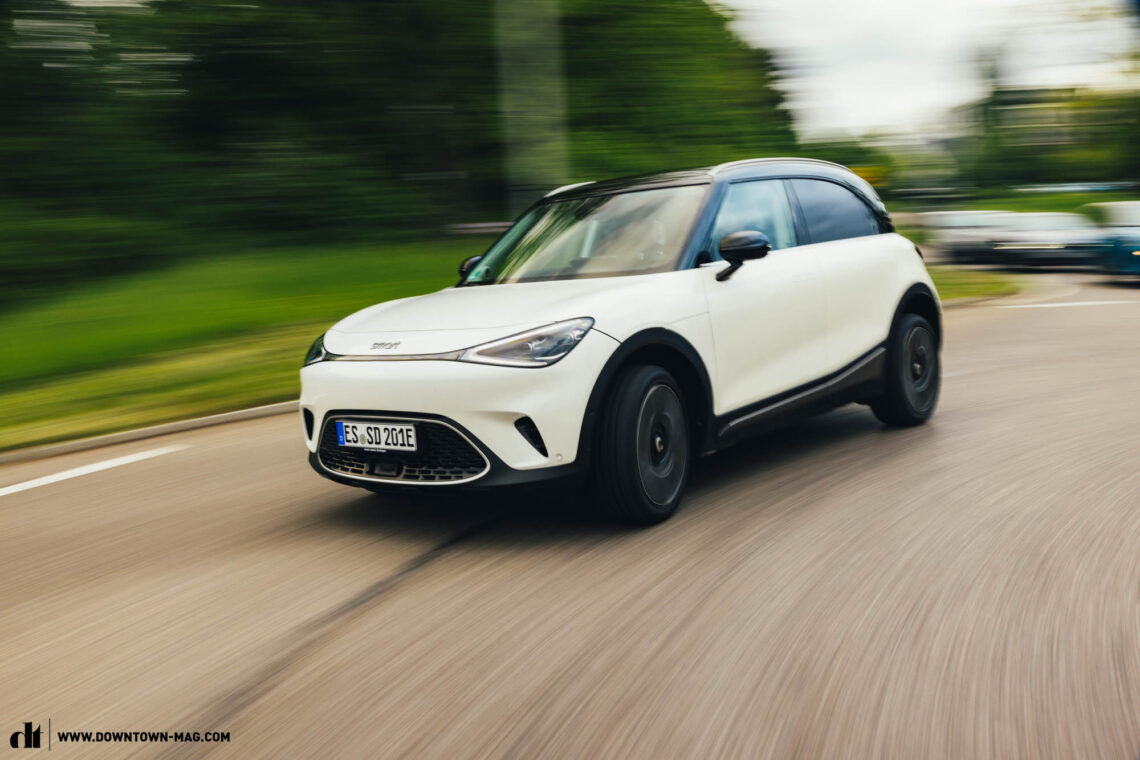
All #1 models are equipped with LED headlights, though the adaptive matrix LED high beam and dynamic LED taillights are exclusive to the Premium line and upwards. The same applies to the leather seats – the alternative being synthetic leather –, the Beats sound system, the 10-inch head-up display, and the park assist function with 12 sensors. All models can accommodate a trailer hitch, with bearing load capacity of 75 kg and certified to pull a whopping 1.600 kg This will be music to the ears of DIY enthusiasts and those who value cargo hauling capabilities. Not to mention cyclists who want to transport their bike on a rear carrier.


The assistance systems in the Smart #1 – What is (not yet) smart on the Smart?
When you first look at the interior, you immediately notice the large, centrally positioned screen, which reminds us of the Model 3. In contrast to Tesla, however, Smart’s engineers don’t rely solely on the central 12.8″ display, pairing it with a 9.2″ wide-format speedometer and – upwards from the Premium line – a 10″ head-up display. The latter is particularly convenient while driving and helps you to focus on the road. The main purpose of the central display is to make all the necessary adjustments, to plan routes, or to operate the air conditioning. The purpose developed software seems very playful at first glance, but it’s largely intuitive to use. The differently portrayed globes depending on the driving mode – such as a playground for “Sport” or a green meadow full of PV panels and wind turbines for “Eco” – are lovingly designed, and the red fox as a digital assistant adds a personal touch. It also responds to a host of voice commands, which can be used to operate the climate control, windows, or sunroof blind, for example. Unfortunately, the playful animations of the fox don’t always run smoothly, and its movements can be a little distracting.

In terms of driver assist functions, you’ve got just about everything on board: Adaptive Cruise Control, Lane Keep and Lane Change Assist, and automatic Park Assist with 360°cameras, which indicates the distance to objects in centimetres instead of just beeping. This instils you with additional confidence, which is necessary considering how fine the Park Assist likes cutting things. The behaviour of the Steering Assist is less confidence-inspiring, which let us drive with no hands for what felt like 2 minutes before it deactivated itself. All the crucial notifications regarding assist functions and navigation get projected onto the head-up display, remaining easy to read in all light conditions. We got accustomed to using the driver assist functions quite quickly during the test. As we did to the very prominent attention warning function, which gets triggered even if you just blink a little too slowly and covers the navigation instructions on the display with warning messages. It’s a very useful safety feature and although it can be deactivated, it is active by default every time you start up the vehicle.


We weren’t as convinced by the navigation system, which is still in need of further refinement in many respects (software version 20.33.10.223662.30212). For example, it doesn’t always suggest the most sensible route and is far too optimistic about the estimated time of arrival. Compared to Google Maps, the Smart #1 calculates the travelling time to be approximately 20% shorter – charging stops included mind you. 1.5 hours quicker than an internal combustion driven vehicle including three charging stops? Not in this EV lifetime! As such, the navigation system has plenty of room for improvement yet. Although it will include charging stops in the route on request, it won’t adjust them dynamically if necessary. With a manual search along the route, the system also displays charging stations that you’ve already passed or are in the opposite direction of travel. You can’t set the minimum state of charge with which you would like to arrive at the next charging station or destination either. These are features we expect from the latest generation of EVs. The system will occasionally fail to recognise town signs, and it will at times indicate the speed limit applicable to a country road when you’re on the highway. The Smart #1 doesn’t seem to have a permanent live traffic feature yet, or our test car just wasn’t permanently online. At least entering your destination via voice command usually works.

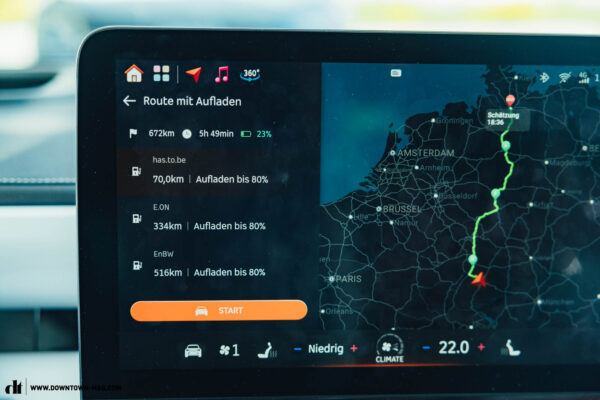

The sharing technology is a nice bonus feature. Thanks to the digital key, you can share the Smart #1 with others simply by giving access to the vehicle via the associated app and unlocking certain functions. It’s based on peer-2-peer technology. Regarding Pet mode, Smart must have gotten their inspiration from Tesla’s Dog mode. And why not? Good ideas will get imitated – and your pet gets the benefit of a pleasant climate in the interior while you’re shopping.

Smart #1 – Range, charging and consumption
An EV that rolls onto the roads in 2023 simply must be up to date regarding the electric specifications if it wants to stand a chance against the competition. And while the Smart #1 doesn’t seem to offer anything extraordinary at first glance, it’s worth having a closer look. With its 66-kWh battery, the #1 has a comparatively large capacity for a compact EV, even if the realistically usable capacity is somewhere between 62 and 64 kWh, providing a range of at least 440 km according to WLTP. However, the charging speed is even more important than the range. And this is where the Smart #1 shines in two respects, offering a charging speed of up to 150 kW of fast chargers and a maximum of 22 kW via domestic and inner-city AC chargers – you’ll be hard pressed to find a compact EV currently on the market that can match these values.


With a single-digit battery level and a warm battery, the Smart #1 will reach the 150-kW maximum relatively quickly at a fast-charging station, though the charging curve starts dropping even at a low double-digit SoC, which is typical for a 400-volt system. However, the manufacturer’s promise of being able to charge from 10 to 80 % in 30 minutes is realistic. With a measured consumption of around 17–20 kWh/100 km, a 30-minute recharge gives you a range of about 235–280 kilometres. Respect! Certainly, the claimed WLTP range of 440 km is only possible in ideal conditions, i.e. warm temperatures and moderate speeds on country roads. Unfortunately, none of this mitigates the fact that the charging port is placed at the rear left of the car, which is senseless on European roads.
On the other hand, Smart’s engineers have taken a clever approach to the issue of regenerative braking. While other manufacturers don’t offer any options at all (just one-pedal driving in the Tesla) or go overboard several stages (like the KIA), the #1 strikes a nice balance. You can choose between either heavy or moderate motor braking and activate one-pedal driving on top of that if desired. It doesn’t get much better than this.
The Smart #1 in review – Driving the Smart #1
So, we’ve established that it’s got plenty of smart technology. But how smart is the Smart #1 on the road? First of all, it doesn’t feel like a typical SUV. Despite its height, it feels planted on the road, and the rear-wheel drive prevents the steering from being affected by the drivetrain, even lending the #1 a sporty character. This is underlined by the comfortable, well-shaped bucket seats, which offer sufficient lateral support through fast corners. Both front seats can be adjusted electrically and provide adjustable lumbar support. As the name suggests, the Easy-Entry function makes getting in and out easier. The pleasantly quiet interior despite the frameless doors also increases the overall driving comfort. It’s only at speeds beyond 160 km/h that things start getting noisy. The Smart #1 tops out at a maximum speed of 180 km/h. From our point of view, this is perfectly fine: the #1 isn’t a sports car, and due to its SUV genes, its electricity consumption increases disproportionately at high speeds, especially when compared to the very efficient Tesla Model 3, for example. As much thought as Smart have given to the lighting, as unimaginative is the sound design. The car always hums quietly, no matter which mode you’re in. It doesn’t exactly evoke emotion.


There are two levels of regenerative braking available. The moderate level almost feels like a sail, whereas the slightly heavier regenerative braking feels like a normal engine brake. However, that classic e-feeling can only be achieved in “E-Pedal” mode. This offers true one-pedal driving, providing a high level of deceleration all the way to a standstill in conjunction with the brake lights. One-pedal driving is significantly more comfortable, especially in inner city traffic, since you don’t have to dance tango on the pedals, as long as you look far enough ahead.
The 360°camera provides an added level of safety, not just displaying the distance to objects in centimetres, but also offering a view of your blind spot obliquely from the front. The top view, on the other hand, is more of a fun gimmick. Unfortunately, the mirror adjustment can also be somewhat gimmicky in an annoying way. There are no buttons to do so, and the corresponding settings are hidden in the depths of the menu. But there’s a little trick that makes things a lot simpler: when tapping on the seat controls on the side of the seat, the mirror settings menu pops up on the central display at the same time, which you can then adjust via the user-friendly steering wheel buttons.

Who is and isn’t the new Smart #1 for?
With the original Smart, this question was easy to answer. It was for city dwellers who were ahead of their time, and a maximum of two people, of course. The target group of the #1 is significantly bigger – and yet it isn’t. Because the original Smart, launched at the turn of the millennium, still had a clearly defined image, whereas the current model is soft around the edges, replaceable, and indifferent. Looking at it this way, the Smart #1 somehow suits everyone and no one simultaneously. It has become slightly too large for inner-city traffic, and it’s not all that suitable as a long-haul vehicle either due to the size of the battery and conditional charging speed. The driving comfort, on the other hand, is impeccable. Despite the spacious interior, which can comfortably accommodate 4 adults, the trunk is only big enough for hand luggage. As such, you can only go on a road trip with four people if they know how to pack minimally. HOWEVER: if you want to drive an electric car, you will have to make some kind of compromise with every EV currently on the market. Smart have managed to make these acceptable in most cases with the #1. Ultimately, the car works well in the suburbs, is suitable for occasional trips – despite the disappointing navigation – and is likely to serve most folks well as their first vehicle. And isn’t that what we want from electric mobility? You won’t save the world with a car. The Smart #1 isn’t the right car for all those who are looking for a truly smart EV, offering smart solutions, compact dimensions, and a distinct design. Let’s say it like it is: the Smart has become mainstream, with all the pros and cons. And it is no longer cheap, either.

Conclusion on the Smart #1
The original Smart wasn’t just small, agile, and snazzy, but also special. However, the new Smart #1 is nothing more than a comfortable, safe, and confidence inspiring car for the suburbs and occasional road trips, in no way remarkable or standing out from the masses of current EVs. Moreover, while the € 44,990 Smart #1 Premium ticks a lot of the right boxes, the driver assist functions lack the level of refinement we expect from a modern EV, especially regarding the navigation system.
Tops
- confidence inspiring handling
- long range
- good voice command system
Flops
- unremarkable design without corners and edges
- uninspiring e-sound
- poor speed limit detection
- overambitious arrival time calculations and poor charging stop planning
- tiny frunk
Words: Patrick Gruber Photos: Peter Walker, Robin Schmitt






